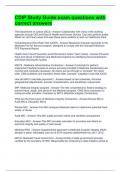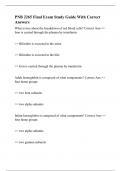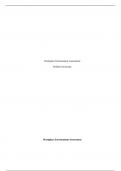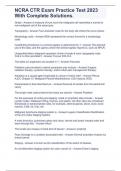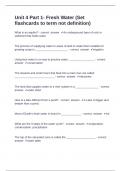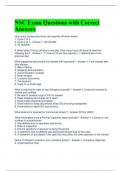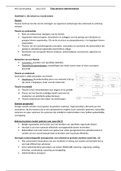4th ed.: Ch1, 2, 5-10
Methodology
Variable = observable/hypothetical events that can change and whose changes can be measured.
Independent variable = manipulated variable controlled by experimenter predictor
Dependent variable = observed effect outcome.
Extraneous variable = not of interest to researcher but might influence variables of interest.
If this is not controlled confounding variable
Different levels of measurement:
Nominal = category without logical order, if 2 categories = dichotomous categorical
Ordinal = categories with specific rank (score 1-100) categorical
Discrete = counts with finite values 1, 2, 3 etc. quantitative
Continuous = scale variables with infinite values quantitative
Research designs can be dependent = one group exposed to both environments. Independent = one
group in one environment, other group in other environment.
Observational:
Cross-sectional = measurement at one time
Case control = one measurement now and one in the past
Cohort = report information over time
Experimental:
Randomized control design = two different groups used
Cross-over design = same participants in control and treatment
Descripting statistics
Measures of central tendency: mean, median and mode. Measures of dispersion/variability: range,
variance, SD etc.
Mean = average value, mostly used with quantitative data, sensitive to outliers and exact
distances
Median = value at median location, if even number of data taking the mean of the 2
medians, ordinal data and unaffected by outliers
Mode = most frequently occurring value in data set, can be 2 modes, nominal data and
unaffected by outliers
Dispersion and variability:
Range = difference between highest and lowest score, sensitive to outliers and
unrepresentative of features between extremes
Interquartile range = distance between Q3 and Q1, most useful for ordinal data and
unaffected by outliers
Variance = estimate of average amount by which the scores in the sample deviate from
mean score
Standard deviation = estimate of average amount by which scores in samples deviate from
mean score, most sensitive measure for quantitative data
, Inferential statistics
Statistical tests are based on probability distributions and measures of uncertainty. ¬ = ‘not’, ∩ =
‘and’, | means ‘given the information that’ A conditional probability.
Complement rule Pr(¬event) = 1 – Pr(event)
Multiplicationn for independent events Pr(A ∩ B) = Pr(A) x Pr(B)
General multiplication rule Pr(A ∩ B) = Pr(A) x Pr(B|A)
o Pr(B|A) = Pr(A ∩ B) Pr(A)


